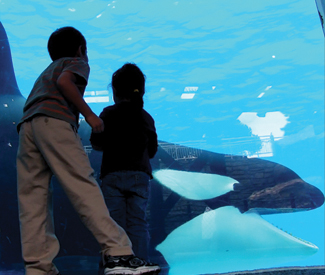cheryl@sfbg.com
FILM The 911 call placed from SeaWorld Orlando on February 24, 2010 imparted a uniquely horrific emergency: “A whale has eaten one of the trainers.” That revelation opens Gabriela Cowperthwaite’s Blackfish, a powerful doc that puts forth a compelling argument against keeping orcas in captivity, much less making them do choreographed tricks in front of tourists at Shamu Stadium.
Whale experts, former SeaWorld employees, and civilian eyewitnesses step forward to illuminate an industry that seemingly places a higher value on profits than on safety — skewed priorities that made headlines after veteran trainer Dawn Brancheau was killed by Tilikum, a massive bull who’d been involved in two prior deaths. (Though SeaWorld refused to speak with Cowperthwaite on camera, they recently released a statement calling Blackfish “shamefully dishonest, deliberately misleading, and scientifically inaccurate;” read the filmmaker’s response to SeaWorld’s criticisms at film blog Indiewire.) Blackfish, which premiered locally at the San Francisco International Film Festival, opens theatrically this week. I spoke with Cowperthwaite ahead of its release.
SF Bay Guardian Blackfish uses home-movie footage to illustrate training accidents, whale misbehavior, and so forth. I’m guessing a company as image-conscious as SeaWorld would strive to keep that kind of material out of the public eye. How did you get ahold of it?
Gabriela Cowperthwaite It came from every source imaginable: personal archives, historical archives, people who happened to be filming shows when they were visitors at the park. We had to vet every piece of footage, figure out the original owner, and go from there. It was the most time-consuming process imaginable — but we really needed to be inside the park to tell the story, so we had no choice but to really do the detective work to find out where every little bit came from.
SFBG Did you do any of your own clandestine filming at SeaWorld?
GC We kind of had to. I had to “meet” Tilikum, you know? Whatever we could do to get footage that could truthfully represent the story, we did.
SFBG The film interviews several former SeaWorld trainers who seem eager to speak out against the park. How did you find them?
GC When they heard how SeaWorld responded to Dawn Brancheau’s death in the news, they knew something was amiss and they began speaking out. In terms of them being comfortable [with being in] the film, they had spoken to author Tim Zimmerman [for the] Outside magazine article “Killer in the Pool,” and had felt a level of comfort with him. His article was one of the best articles I read about the Brancheau case. So from that, I was able to contact them. Their only caveat was that the film [would have to] be truthful, and I told them I planned to do a fact-based narrative that wasn’t sensationalized or gratuitous. Because we saw eye to eye on that approach, they agreed to be interviewed.
SFBG Blackfish highlights the disconnect between SeaWorld’s version of Brancheau’s death and what the trainers suspect actually happened. Their analysis of the video shot in the moments leading up to the attack is very effective.
GC It’s exactly what you want to know because you can’t understand what’s happening. The lay viewer sees a whale circling a pool; there’s nothing other than, “Isn’t this a cute trick?” Audience members at these shows are trained just as much as the whales are, to respond and laugh and clap on cue. And yet, to have a trainer say, “Oh no, this session is going badly” — that was so eye opening for me, and I could only learn that from these former trainers.
SFBG What do you think would be the best-case scenario for whales in captivity, going forward?
GC If SeaWorld were to stop its breeding program, that would be hugely important. And one of the best alternatives [for whales in the park] is instituting a sea pen, which is essentially cordoning off part of an ocean cove with a big net. You can’t just dump [the whales] into the ocean because they don’t know how to eat live fish, and a lot of them are hopped up on antibiotics. But you could soft-release them and keep them in a place where you could monitor their health, and yet allow them to be in an ocean environment. That would be an amazing thing that SeaWorld could do.
SFBG You mentioned that you had gone to see Tilikum in person. What was that like?
GC I was terrified of Tilikum when I first started making the documentary — I think because I’d read [Brancheau’s] autopsy report early on, and it was the stuff of nightmares. But when I started unpacking his life to try and understand [him], I started feeling this empathy. It culminated with me seeing him and truly feeling sorry for this tremendous, impossible animal — relegated to doing this silly lap around the pool and splashing everybody, and then going right back into his little pool.
SFBG And SeaWorld doesn’t acknowledge that it’s the whale that killed the trainer, of course.
GC Oh no. Absolutely not. They just don’t talk about it. And remember, they call everything Shamu. That’s the easiest way not to have to deal with the Tilikum factor.
BLACKFISH opens Fri/26 in Bay Area theaters.

